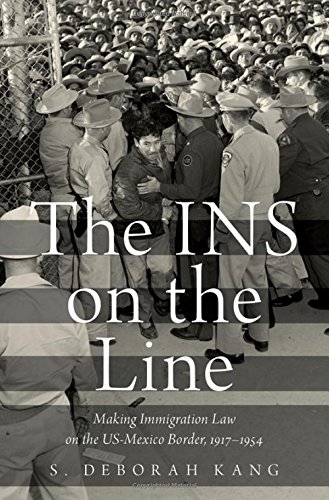(Ebook) The INS on the line: making immigration law on the US-Mexico border, 1917-1954 by S. Deborah Kang ISBN 9780199757435, 0199757437
For much of the twentieth century, Immigration and Naturalization Service (INS) officials recognized that the US-Mexico border region was a special case. Here, the INS confronted a set of political, social, and environmental obstacles that prevented it from replicating its achievements at the immigration stations of Angel Island and Ellis Island. In response to these challenges, local INS officials resorted to the
law--amending, nullifying, and even rewriting the nation's immigration laws for the borderlands, as well as enforcing them. In The INS on the Line, S. Deborah Kang traces the ways in which the INS on the US-Mexico border made the nation's immigration laws over the course of the twentieth century. While the INS is primarily thought to be a law enforcement agency, Kang demonstrates that the agency also defined itself as a lawmaking body. Through a nuanced examination of the agency's admission, deportation, and enforcement practices in the Southwest, she reveals how local immigration officials constructed a complex approach to border control, one that closed the line in the name of nativism and national security, opened it for the benefit of transnational economic and social concerns, and redefined it as a vast legal jurisdiction for the policing of undocumented immigrants. Despite its contingent and local origins, this composite approach to border control, Kang concludes, continues to inform the daily operations of the nation's immigration agencies, American immigration law and policy, and conceptions of this border today" Abstract: For much of the twentieth century, Immigration and Naturalization Service (INS) officials recognized that the US-Mexico border region was a special case. Here, the INS confronted a set of political, social, and environmental obstacles that prevented it from replicating its achievements at the immigration stations of Angel Island and Ellis Island. In response to these challenges, local INS officials resorted to the law--amending, nullifying, and even rewriting the nation's immigration laws for the borderlands, as well as enforcing them. In The INS on the Line, S. Deborah Kang traces the ways in which the INS on the US-Mexico border made the nation's immigration laws over the course of the twentieth century. While the INS is primarily thought to be a law enforcement agency, Kang demonstrates that the agency also defined itself as a lawmaking body. Through a nuanced examination of the agency's admission, deportation, and enforcement practices in the Southwest, she reveals how local immigration officials constructed a complex approach to border control, one that closed the line in the name of nativism and national security, opened it for the benefit of transnational economic and social concerns, and redefined it as a vast legal jurisdiction for the policing of undocumented immigrants. Despite its contingent and local origins, this composite approach to border control, Kang concludes, continues to inform the daily operations of the nation's immigration agencies, American immigration law and policy, and conceptions of this border today"
*Free conversion of into popular formats such as PDF, DOCX, DOC, AZW, EPUB, and MOBI after payment.


